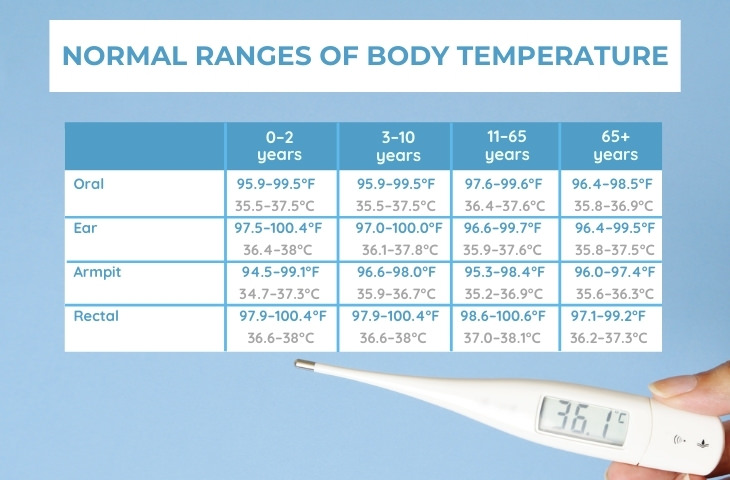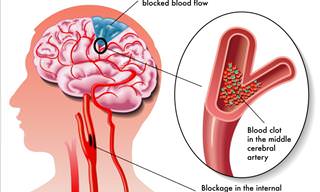While using a thermometer is the most definitive way to tell if you have a fever, it’s by far not the only way to know whether or your body temperature has reached alarmingly high levels. In fact, if you don’t have a thermometer on hand, you can still detect a fever by its other symptoms.
Normal Temperature is Relative
As a matter of fact, doctors now know that what is considered “normal” body temperature is relative - not only does the body temperature fluctuate throughout the day, but it also changes with age, throughout the menstrual cycle in women, and just from one individual to another.
The table above shows the range of what is considered a normal body temperature based on age and how it is measured. If you want to know what the normal body temperature is for you, try creating a body temperature journal by measuring and writing down your body temperature in the morning and evening every day for a few weeks to a month.
What does this relativity of body temperature mean for you? Practically speaking, this means that your normal body temperature may be lower or higher than the “gold standard” temperature of 98.6°F (36.6°C). It also means that it may be difficult for you to detect if you have a low-grade fever based on your body temperature alone.
Being able to detect a persistent low-grade fever, in turn, is quite useful, especially if other symptoms are also present, as it could point to several underdiagnosed health conditions in their early stages, including thyroid issues, autoimmune diseases, tuberculosis, and even cancer. This is exactly why understanding the symptoms of fever and being able to detect it on time is so very important.
What are the symptoms of a fever?

When you’re not able to take your temperature or suspect that you might have a fever, watch out for any of the following symptoms that often accompany a fever:
- Dehydration. Although many people are not aware of this, a fever can be dehydrating for the body, which is, in part, why your doctor will always stress for you to drink plenty of water when you have the flu that’s accompanied by a high fever. So, a dry mouth and thirst may point to a fever.
Sometimes, when the dehydration is quite extreme, people may even experience confusion and brain fog when they have a fever. This symptom is closely linked with the next symptom we discuss.
- Sweating. You’re likely aware of the phenomenon of night sweats, which people with respiratory infections often experience. Although sweating at night is a hallmark of the flu, bronchitis, and pneumonia, a high fever of any cause may make you sweat excessively.
This is because sweating is the way our body naturally tries to cool down when we’re running a fever, but if you don’t drink enough, it could lead to dehydration. As Dr. Jordana Haber pointed out to the Insider, "With high fevers, we can lose a significant amount of fluid through sweating."

- Chills. One of the most common symptoms of fever is shivering and chills throughout the body. In fact, for many people, chills are the surest way to determine that they have a fever. Chills are especially common at the onset of a disease when the body is trying to raise its temperature to kill germs.
- Red cheeks. The flushing of the face and the body, especially the chest area is another common symptom of fever. This process occurs when the blood vessels are dilated in order to increase the blood flow to the various body parts and allow infection-fighting immune cells arrive and kill pathogens more quickly. You might even feel like your cheeks and forehead are burning.
- Muscle aches and weakness. Muscle aches that are not caused by physical activity can point to a great many different health conditions, but infections are probably the most common one. Apart from aching muscles and joints, you may also experience weakness and a headache. These pains and soreness are a side effect of the active immune response to a pathogen.
When our body detects a virus, be it the flu or any bacterium, virus, or another pathogen, it starts releasing compounds called cytokines to alert the immune system of the intruders. These inflammatory proteins, though beneficial, also have the side effect of breaking down muscle tissues, which results in muscle aches and fatigue.
Related Article: 8 Unexpected Causes of Fever
When to Be Concerned
If you’re experiencing any of these symptoms, but cannot measure your temperature accurately using a thermometer, you can still be sure that what you feel is, in fact, a fever. Of course, you can also feel your forehead and see if it’s hot to the touch or ask someone else to do it for you. While it can help further confirm your suspicion, a hot forehead on its own is not a definitive symptom of fever.
Over time, if you pay attention to all of these symptoms, you’ll learn to establish whether or not you have a fever even without a thermometer, it just takes a bit of practice and mindfulness. Though a fever that continues for a day or two, or a fever due to the flu or the cold is no reason for concern, you should be alarmed and seek medical attention if your fever continues for over a week or if it’s higher than 104°F (40°C).
Share this article with family and friends!
 Go to BabaMail
Go to BabaMail


























